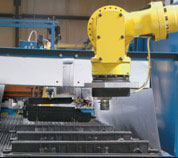Painting plastic parts is a common practice in various industries, including automotive, electronics, and consumer goods. These parts need to be painted to improve their appearance, protect them from corrosion, and enhance their durability. Traditionally, this process has been done manually, which can be time-consuming, labor-intensive, and error-prone. However, with the advent of automation, this process can be streamlined and made more efficient. In this blog post, we will discuss the benefits of automating the process of painting plastic parts.
Increased Efficiency Automating the process of painting plastic parts can significantly increase efficiency and reduce the time it takes to complete the task. This is because automation eliminates the need for manual labor, which can be slow and prone to errors. With automation, parts can be painted quickly and accurately, resulting in faster production times and lower costs.
Consistency Manual painting can result in inconsistent results, as different operators may apply the paint with different thicknesses, coverage, and finishes. However, with automated painting, the process can be standardized, ensuring that each part receives the same amount of paint, with the same coverage, and finish. This consistency ensures that the parts meet the required quality standards, which is essential in industries such as automotive and aerospace.
Improved Quality Automating the painting process can also improve the quality of the finished product. Automated systems are designed to be precise and accurate, resulting in a higher quality finish. The consistency of the paint application also results in a more uniform appearance, which can improve the overall aesthetic of the part. Furthermore, automated systems can be programmed to detect and correct any defects or imperfections in the paint job, ensuring that the finished product meets the required quality standards.
Reduced Costs Automating the painting process can also lead to reduced costs. While the initial investment in an automated painting system can be high, the long-term cost savings can be significant. Automated systems can reduce the amount of paint used, as they can apply the paint more accurately and consistently than manual labor. They can also reduce the amount of waste generated during the painting process, as any excess paint can be collected and reused. Furthermore, automated systems can reduce the need for rework or touch-up, as they can detect and correct any defects in the paint job, resulting in fewer rejected parts.
Safer Work Environment Manual painting can be hazardous, as it involves the use of potentially harmful chemicals and requires operators to be in close proximity to the painting process. Automating the process of painting plastic parts can help to create a safer work environment by reducing the amount of exposure to these chemicals. Automated systems can also be equipped with safety features such as sensors and alarms, which can detect and respond to any potential safety hazards.
Increased Capacity Automating the painting process can also increase the capacity of the production line. Automated systems can paint parts faster and more accurately than manual labor, resulting in increased throughput and higher production volumes. This increased capacity can help companies to meet growing demand and increase their competitiveness in the market.
Improved Flexibility Automated painting systems can also offer improved flexibility compared to manual labor. They can be programmed to paint a variety of different parts, shapes, and sizes, making them suitable for a wide range of applications. They can also be reprogrammed quickly and easily, allowing for changes in production requirements or product designs.
Automating the process of painting plastic parts offers numerous benefits, including increased efficiency, consistency, quality, cost savings, safety, capacity, and flexibility. These benefits can help companies to improve their production processes, reduce costs, increase competitiveness, and deliver high-quality products to their customers. As such, investing in an automated painting system can be a smart business decision for companies in various industries.
